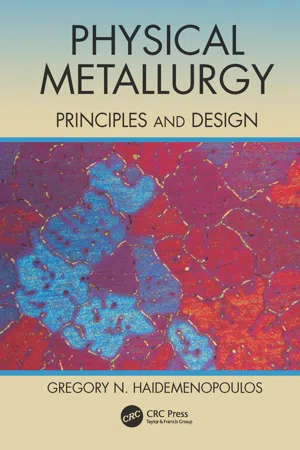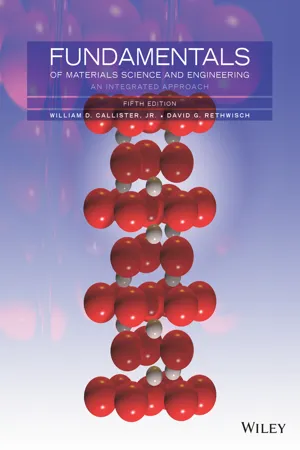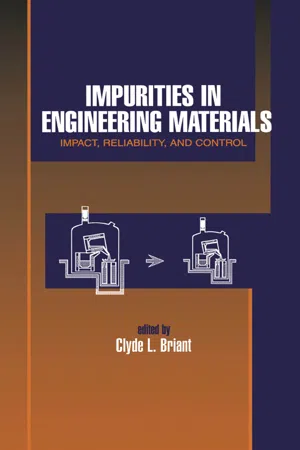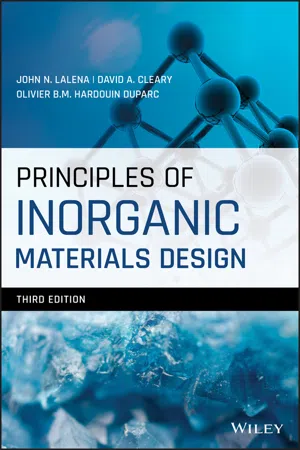Technology & Engineering
Solid Solution Strengthening
Solid solution strengthening is a method of strengthening materials by adding atoms of a different element to the crystal lattice of the base material. This disrupts the regular arrangement of atoms, making it more difficult for dislocations to move through the material, thus increasing its strength. This process is commonly used in the manufacturing of alloys to improve their mechanical properties.
Written by Perlego with AI-assistance
Related key terms
Related key terms
1 of 4
Related key terms
1 of 3
5 Key excerpts on "Solid Solution Strengthening"
- eBook - ePub
Physical Metallurgy
Principles and Design
- Gregory N. Haidemenopoulos(Author)
- 2018(Publication Date)
- CRC Press(Publisher)
8Strengthening mechanisms
8.1 Introduction
Pure metals are soft materials. For most engineering applications they cannot provide the required strength. This is the reason alloys were invented. The strength of metals can be increased by alloying and by certain thermal, mechanical or thermomechanical processing. In the previous chapter we have seen that the plastic deformation of metals proceeds by the glide of dislocations, a process we called slip. Strengthening can be achieved by creating obstacles to dislocation glide. It is these obstacles that are created with the alloying and suitable processing discussed above. The strengthening mechanisms, which is the subject of the present chapter, are simply mechanisms of interaction between dislocations and various obstacles. The major mechanisms are: lattice resistance, strain hardening, Solid Solution Strengthening, grain boundary strengthening and precipitation strengthening. In lattice resistance, the main obstacle to dislocation glide is the crystal lattice, the atomic bonds in particular. In strain hardening the main obstacle impeding dislocation glide is other dislocations. The interaction between dislocations forms sessile dislocations, which cannot contribute to plastic deformation. Strain hardening has been discussed in detail in the previous chapter and will not be considered further. In Solid Solution Strengthening the obstacles are solute atoms, either substitutional or interstitial, the strain field of which interacts with dislocations. In grain boundary strengthening, the obstacles are high-angle grain boundaries, but also sub-boundaries and interfaces as the interfaces between ferrite and cementite in pearlite or the interfaces between martensite laths. Finally, in precipitation strengthening, the obstacles are precipitates, second-phase particles or intermetallic compounds formed during thermal processing. In most alloys the yield strength is the result of a superposition of strengthening mechanisms. The effectiveness of each mechanism is characterized by the specific obstacle strength, which is related to the stress required to overcome the obstacles at T = 0K - eBook - ePub
Fundamentals of Materials Science and Engineering
An Integrated Approach
- William D. Callister, Jr., David G. Rethwisch(Authors)
- 2018(Publication Date)
- Wiley(Publisher)
15.1 .8.10 SOLID-SOLUTION STRENGTHENING
solid-solution strengtheningAnother technique to strengthen and harden metals is alloying with impurity atoms that go into either substitutional or interstitial solid solution. Accordingly, this is called. High-purity metals are almost always softer and weaker than alloys composed of the same base metal. Increasing the concentration of the impurity results in an attendant increase in tensile and yield strengths, as indicated in Figuressolid-solution strengthening8.16aand8.16b, respectively, for nickel in copper; the dependence of ductility on nickel concentration is presented in Figure8.16c.Solid Solution StrengtheningVMSE:Variation with nickel content of (a ) tensile strength, (b ) yield strength, and (c ) ductility (%EL) for copper–nickel alloys, showing strengthening.Figure 8.16Alloys are stronger than pure metals because impurity atoms that go into solid solution typically impose lattice strains on the surrounding host atoms. Lattice strain field interactions between dislocations and these impurity atoms result, and, consequently, dislocation movement is restricted. For example, an impurity atom that is smaller than a host atom for which it substitutes exerts tensile strains on the surrounding crystal lattice, as illustrated in Figure8.17a. Conversely, a larger substitutional atom imposes compressive strains in its vicinity (Figure8.18a). These solute atoms tend to diffuse to and segregate around dislocations in such a way as to reduce the overall strain energy—that is, to cancel some of the strain in the lattice surrounding a dislocation. To accomplish this, a smaller impurity atom is located where its tensile strain partially nullifies some of the dislocation’s compressive strain. For the edge dislocation in Figure8.17b, this would be adjacent to the dislocation line and above the slip plane. A larger impurity atom would be situated as in Figure8.18b - eBook - ePub
Impurities in Engineering Materials
ImPatt, Reliability, & Control
- Clyde Briant(Author)
- 2017(Publication Date)
- Routledge(Publisher)
9Solid Solution Hardening by ImpuritiesTetsuo Mohri and Tomoo Suzuki*Hokkaido University Sapporo, JapanI Introduction
Solid solution hardening is a typical hardening behavior observed commonly in all classes of metallic alloy systems including off-stoichiometric intermetallic compounds. The origin of solid solution hardening is usually ascribed to the interaction between a dislocation and impurities contained in a solid solution that act as obstacles to a moving dislocation. Besides substitutional and interstitial foreign elements, one may include even a vacancy, a forest dislocation, and other defects as impurities that have the potential to cause hardening. The magnitude and extension of the interaction force depend on the kind of impurities. The primary mission of the study of solid solution hardening is to clarify the elementary interaction mechanism and to estimate the magnitude of the interaction force for each obstacle on the basis of dislocation theory.In general, the critical resolved shear stress (CRSS) of a solid solution cannot be given as a simple sum of an elementary interaction force over all impurities encountered by a dislocation line. This is because a non-linear dislocation line, due to a finite magnitude of line tension, is subject to various averaging processes during multiple interactions with impurities on a slip plane. Thus, the study of solid solution hardening requires a statistical treatment to clarify the functional dependence of CRSS on the concentration and distribution of an impurity and the extension of its interaction field, the line tension of a dislocation line, etc., without going into the details of the mechanism of interaction with an impurity.The two subjects described above concern the interactions of a single dislocation line with impurities. In order to analyze and understand experimentally observed solid solution hardening behavior, however, one also needs to take the dislocationdislocation interactions into account, since the actual deformation process is driven by dislocations that have a density on the order of 106 – 1012 cm/cm3 - eBook - ePub
- John N. Lalena, David A. Cleary, Olivier B.M. Hardouin Duparc(Authors)
- 2020(Publication Date)
- Wiley(Publisher)
In the latter circumstance, it should be possible to extrapolate the properties from those of the coarse‐grained samples. Still yet, some experiments indicate that the yield stress is independent of grain size in this size regime (Lu and Liaw 2001). Other strengthening mechanisms include solid solution formation, strain hardening, and precipitation or age hardening. Solid‐solution strengthening involves replacing a small number of atoms in the lattice with substitutional impurities of a slightly different size. This creates strain in the crystal, inhibiting the movement of dislocations and strengthening the material. Note that solid solubility is not reciprocal. Thus, silver will dissolve up to 5% bismuth, but the solubility of silver in bismuth is negligible. Strain hardening is accomplished by cold working a material at room temperature such as rolling, drawing, or extruding to produce elongation of the grains in the principle direction of working. The dislocation density will increase with the percent area reduction. This allows dislocations to become entangled and pinned, thus strengthening the material. Unlike decreases in grain size, both strain hardening and solid‐solution strengthening lower ductility. Annealing a strain‐hardened sample can restore the loss in ductility through a process of recrystallization and grain growth, in which dislocation pileups are removed via, for example, grain boundary migration. Finally, precipitation hardening (a.k.a. age hardening and particle hardening) relies on a change in the solid solubility with temperature to produce fine dispersions of particles of an impurity phase, which impede the movement of dislocations, to harden the material. The detrimental effects of cold working can be avoided altogether by hot working. Hot working is the shaping or deformation of a metal just above its recrystallization temperature (~0.4 T M, where T M is the melting temperature) - eBook - ePub
Functional Materials
Preparation, Processing and Applications
- S. Banerjee, A.K. Tyagi, A. K. Tyagi(Authors)
- 2011(Publication Date)
- Elsevier(Publisher)
It is clear from the foregoing that it is not trivial to obtain all the desired mechanical properties in a given material chosen for a specific application. Traditionally, materials scientists manipulate the defects in crystalline materials such as precipitates, grain boundaries (Hall–Petch relationship), interstitial atoms, vacancies or substitutional atoms to create materials with the desired properties. However, during the past two decades researchers have made some incredible advances across a range of materials such as metals, ceramics, composites, metallic glasses and nano-composites, which possess super-mechanical properties. These advances became possible because of the increase in the scientific understanding of the relationship between the structure of materials at atomic or molecular scales and their macroscopic properties as a result of the development of strong computational and simulation tools. The advent of nanoscience and nanotechnology has created new fundamentals of understandings and pushed the conventional wisdom on materials to new levels. The new understandings have been validated by advances in processing and production techniques and the advent of advanced structural and analytical characterization instruments such as high resolution microscopy, X-ray diffraction, small-angle X-ray scattering (SAXS), three-dimensional atom probes, and atomic force microscopy (AFM), which enabled precise description of structures to be performed. These developments have propelled the efforts to create strong materials.In the following section, we present methodologies that have been adopted to achieve ultra-strong materials. They are broadly classified in two categories: (i) strengthening by refining the length scale and (ii) strengthening by changing the bonding nature.11.4.1. Strengthening by Refining Length Scales
Refining Grain Size
Conventional engineering materials have grain sizes of the order of tens to hundreds of micrometres. As the inverse relation between the strength and grain size (Hall–Petch relation) suggests, refining grain size will improve the strength. With this motivation there has been significant effort over the past two decades to refine the grains in metals to levels below that achieved by conventional methods. One such approach is subjecting coarse-grain materials to severe plastic deformation techniques such as equal channel angular pressing, high pressure torsion, accumulative roll bonding, multiple compressions (see reviews in refs. [17] , [18] and [19] ) and friction stir processing (see, for example, [20] , [21] and [22] ) for the refinement of microstructure. It is now routine to obtain materials with grain sizes in the range 200–500nm by these techniques. Achieving grains in the nanometre level is done through electrodeposition, cryomilling, inert gas condensation and many more (for a review see [19] ). Of the severe plastic deformation techniques, high-pressure torsion, is possibly the only one to produce materials with nanoscale grains. Refinement of grains with any of the these other methods increases the strength substantially over that of coarser-grained materials, as depicted schematically in Figure 11.8 . At sizes below 100nm, grain-boundary-mediated mechanisms start becoming prominent and at a few tens of nanometres the strength peaks. At smaller grain sizes it is expected that the strength drops, following an inverse Hall–Petch relation where grain boundary deformation takes over. The strength versus grain size relation for some metals with grain size ranging from the micrometre to sub-micrometre and nanometre range is shown in Figure 11.9A . It is seen that with decreasing grain size the strength increases for all of the metals shown here. This increase is up to a grain size of 20–30nm, after which the magnitude of the slope decreases, very clearly seen for Cu and Fe. For grain sizes beyond 1μm the slope is very similar to the conventional Hall–Petch relation, that is d−0.5 . For Ni, Fe and Ti, having grain sizes below 100nm, the yield strength goes higher than 1GPa. Thus materials with these grain sizes can be considered as ultra-strong. When plotted as yield strength normalized with elastic modulus (Figure 11.9B ), it is seen that for Fe and Ti with grain sizes lower than 30nm the YS/E
Index pages curate the most relevant extracts from our library of academic textbooks. They’ve been created using an in-house natural language model (NLM), each adding context and meaning to key research topics.
Explore more topic indexes
Explore more topic indexes
1 of 6
Explore more topic indexes
1 of 4




